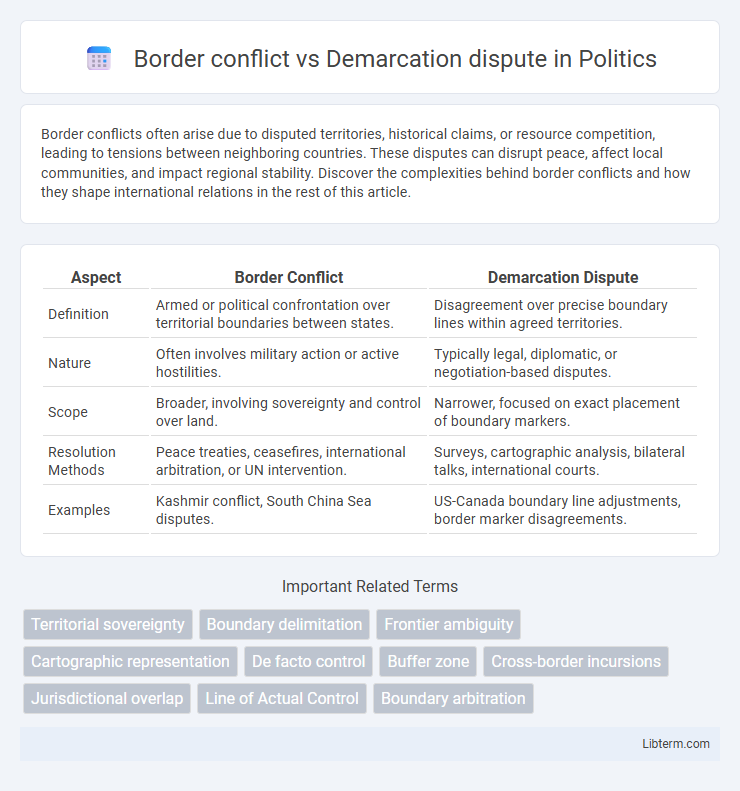Border conflicts often arise due to disputed territories, historical claims, or resource competition, leading to tensions between neighboring countries. These disputes can disrupt peace, affect local communities, and impact regional stability. Discover the complexities behind border conflicts and how they shape international relations in the rest of this article.
Table of Comparison
| Aspect | Border Conflict | Demarcation Dispute |
|---|---|---|
| Definition | Armed or political confrontation over territorial boundaries between states. | Disagreement over precise boundary lines within agreed territories. |
| Nature | Often involves military action or active hostilities. | Typically legal, diplomatic, or negotiation-based disputes. |
| Scope | Broader, involving sovereignty and control over land. | Narrower, focused on exact placement of boundary markers. |
| Resolution Methods | Peace treaties, ceasefires, international arbitration, or UN intervention. | Surveys, cartographic analysis, bilateral talks, international courts. |
| Examples | Kashmir conflict, South China Sea disputes. | US-Canada boundary line adjustments, border marker disagreements. |
Understanding Border Conflicts: Definition and Scope
Border conflicts arise when two or more states or entities claim overlapping territory, often fueled by historical grievances or strategic interests, leading to military or political confrontations. Demarcation disputes are a subset of border conflicts involving disagreements over the precise physical boundary alignment despite agreed-upon general border lines. Understanding border conflicts requires analyzing the causes, such as ethnic divisions, resource competition, and colonial legacies, alongside mechanisms like boundary treaties and international arbitration that seek to resolve demarcation disputes peacefully.
What Constitutes a Demarcation Dispute?
A demarcation dispute arises when there is disagreement over the precise placement or marking of a defined boundary line, often involving detailed surveys or physical markers such as fences or walls. Unlike broader border conflicts that may challenge territorial sovereignty, demarcation disputes specifically concern the interpretation of agreed-upon borders and the exact positioning of boundary indicators. Such disputes frequently occur in regions where historical treaties exist but lack clear, contested, or outdated demarcation evidence, leading to localized tensions without necessarily escalating into full-scale territorial conflicts.
Key Differences Between Border Conflict and Demarcation Dispute
Border conflict involves armed disagreements or tensions between two or more states over territorial sovereignty, often escalating into military confrontations. Demarcation dispute, however, centers on disagreements regarding the physical placement or interpretation of already agreed-upon boundary lines without necessarily involving violence. The key difference lies in border conflicts challenging sovereignty claims, while demarcation disputes focus on precise border line definitions and mapping.
Historical Context: Notable Border Conflicts Worldwide
Historical border conflicts such as the Kashmir dispute between India and Pakistan and the Israel-Palestine conflict demonstrate how territorial claims often ignite prolonged violence and political tension. Unlike demarcation disputes, which typically involve disagreements over precisely where a recognized boundary lies, border conflicts stem from competing sovereignty claims over entire regions. These notable worldwide cases underscore the complexities of colonial legacies, ethnic divisions, and geopolitical interests driving enduring territorial disputes.
Case Studies: Famous Demarcation Disputes
Famous demarcation disputes include the India-Bangladesh enclaves conflict, where ambiguous borders created numerous enclaves leading to protracted negotiations and a Land Boundary Agreement in 2015. The Ecuador-Peru border dispute, resolved through the 1998 Brasilia Presidential Act, exemplifies how clearly defined demarcation can prevent longstanding border conflicts. These cases highlight that demarcation disputes arise from unclear or poorly marked boundaries, distinct from border conflicts rooted in political or ethnic tensions.
Legal Frameworks Governing International Borders
Legal frameworks governing international borders distinguish border conflicts from demarcation disputes by defining sovereignty and territorial rights through treaties, customary international law, and United Nations regulations. Border conflicts often arise from competing claims or violations of established borders, challenging the principles of territorial integrity and non-intervention codified in the UN Charter. Demarcation disputes focus on the precise physical delineation of boundaries agreed upon legally, involving survey protocols and bilateral or multilateral agreements endorsed by bodies like the International Court of Justice and the UN Commission on International Trade Law.
Causes and Consequences of Border Conflicts
Border conflicts arise from disputes over territorial sovereignty due to ambiguous or contested boundaries, often fueled by historical claims, resource competition, and ethnic tensions. Demarcation disputes specifically involve disagreements over the physical placement of boundary lines, frequently caused by poor or outdated cartographic information and divergent interpretations of treaties. Consequences of border conflicts include military confrontations, displacement of populations, disruption of trade, and long-lasting diplomatic tensions that can destabilize regional security.
Resolving Demarcation Disputes: Diplomatic Approaches
Resolving demarcation disputes often involves diplomatic approaches such as bilateral negotiations, third-party mediation, and the establishment of joint boundary commissions to clarify and agree upon precise border lines. These methods prioritize peaceful dialogue and legal frameworks, reducing the risk of escalating border conflicts into violence. Effective resolution hinges on mutual recognition of territorial claims and adherence to international law, fostering long-term stability in disputed regions.
The Role of International Organizations in Border Issues
International organizations such as the United Nations and the International Court of Justice play a critical role in addressing border conflicts and demarcation disputes by facilitating diplomatic negotiations and providing legal frameworks for peaceful resolution. These entities help establish clear boundary demarcations through expert boundary commissions and mediators, reducing the risk of escalation between states. Their involvement ensures adherence to international law, promotes dialogue, and supports monitoring mechanisms to maintain long-term stability in contested border regions.
Future Prospects: Towards Peaceful Border Management
Future prospects for resolving border conflicts and demarcation disputes emphasize collaborative mechanisms such as joint boundary commissions, conflict resolution frameworks, and adherence to international legal standards like the International Court of Justice rulings. Technologies including satellite imagery and geographic information systems enhance accuracy in border demarcation, reducing misunderstandings and fostering mutual trust. Sustained diplomatic engagement coupled with regional cooperation initiatives paves the way for peaceful border management and long-term stability.
Border conflict Infographic

 libterm.com
libterm.com